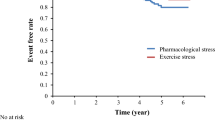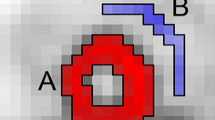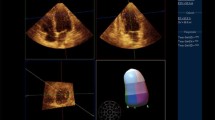Abstract
To compare the measurement of global left-ventricular (LV) function parameters of 64-slice multidetector-row computed tomography (MDCT) between 20- and 10-reconstruction phases. Fifty five patients with suspected or known coronary artery disease underwent 64-slice MDCT. LV end-diastolic volume (EDV), end-systolic volume (ESV), stroke volume (SV), and ejection fraction (EF) were measured from MDCT data sets using threshold-based volume segmentation and reconstruction at every 5% (20 phases) and 10% (10 phases) step through the R-R interval. These global functional parameters were compared to those obtained via two-dimensional transthoracic echocardiography (2D-TTE), considering the reference standard. The required time for CT data analysis was checked. Agreement for parameters of LV global function was determined using Pearson’s correlation coefficient (r) and Bland–Altman analysis. LV volumes (EDV−5% 87.5 ± 17.1 ml, EDV−10% 87.7 ± 16.3 ml; ESV−5% 32.4 ± 10.6 ml, ESV−10% 31.9 ± 9.9 ml; SV−5% 55.1 ± 10.5 ml, SV−10% 55.8 ± 9.9 ml; mean ± SD) and EF (EF−5% 63.4 ± 6.2%, EF−10% 63.9 ± 5.8%) did not differ significantly between the 20- and 10 phase reconstructions, and evidenced good to excellent correlation (r = 0.786–0.896, all P < 0.001) with the 2D-TTE results. The mean required time for CT data analysis in the 20- and 10 phase reconstructions were 15.5 ± 4.0 and 7.3 ± 2.5 min. Within MDCT, using 10-phase image reconstruction is sufficient to evaluate LV volumes and EF, and is also more time-effective than 20-phase reconstruction.



Similar content being viewed by others
Abbreviations
- ECG:
-
Electrocardiography
- HR:
-
Heart rate
- LV:
-
Left ventricle
- LVEDV:
-
Left ventricular end-diastolic volume
- LVEF:
-
Left ventricular ejection fraction
- LVESV:
-
Left ventricular end-systolic volume
- LVSV:
-
Left ventricular stroke volume
- MDCT:
-
Multidetector-row computed tomography
- MRI:
-
Magnetic resonance imaging
- 2D:
-
Two-dimensional
- 2D-TTE:
-
Two-dimensional transthoracic echocardiography
- 3D:
-
Three-dimensional
References
Gerber TC, Behrenbeck T, Allison T et al (1999) Comparison of measurement of left ventricular ejection fraction by Tc-99 m sestamibi first-pass angiography with electron beam computed tomography in patients with anterior wall acute myocardial infarction. Am J Cardiol 83:1022–1026
Schocken DD, Arrieta MI, Leaverton PE et al (1992) Prevalence and mortality rate of congestive heart failure in the United States. J Am Coll Cardiol 20:301–306
White HD, Norris RM, Brown MA et al (1987) Left ventricular end-systolic volume as the major determinant of survival after recovery from myocardial infarction. Circulation 76:44–51
Orakzai SH, Orakzai RH, Nasir K et al (2006) Assessment of cardiac function using multidetector row computed tomography. J Comput Assist Tomogr 30:555–563
Juergens KU, Fischbach R (2006) Left ventricular function studied with MDCT. Eur Radiol 16:342–357
Mahnken AH, Muhlenbruch G, Gunther RW et al (2007) Cardiac CT: coronary arteries and beyond. Eur Radiol 17:994–1008
Miller S, Simonetti OP, Carr J et al (2002) MR Imaging of the heart with cine true fast imaging with steady-state precession: influence of spatial and temporal resolutions on left ventricular functional parameters. Radiology 223:263–269
Mahnken AH, Hohl C, Suess C et al (2006) Influence of heart rate and temporal resolution on left-ventricular volumes in cardiac multislice spiral computed tomography: a phantom study. Invest Radiol 41:429–435
Dewey M, Muller M, Teige F et al (2006) Evaluation of a semiautomatic software tool for left ventricular function analysis with 16-slice computed tomography. Eur Radiol 16:25–31
Dewey M, Muller M, Eddicks S et al (2006) Evaluation of global and regional left ventricular function with 16-slice computed tomography, biplane cineventriculography, and two-dimensional transthoracic echocardiography: comparison with magnetic resonance imaging. J Am Coll Cardiol 48:2034–2044
Henneman MM, Schuijf JD, Jukema JW et al (2006) Assessment of global and regional left ventricular function and volumes with 64-slice MSCT: a comparison with 2D echocardiography. J Nucl Cardiol 13:480–487
Muhlenbruch G, Das M, Hohl C et al (2006) Global left ventricular function in cardiac CT. Evaluation of an automated 3D region-growing segmentation algorithm. Eur Radiol 16:1117–1123
Folland ED, Parisi AF, Moynihan PF et al (1979) Assessment of left ventricular ejection fraction and volumes by real-time, two-dimensional echocardiography. A comparison of cineangiographic and radionuclide techniques. Circulation 60:760–766
Suzuki S, Furui S, Kaminaga T et al (2006) Accuracy and efficiency of left ventricular ejection fraction analysis, using multidetector row computed tomography: effect of image reconstruction window within cardiac phase, slice thickness, and interval of short-axis sections. Circ J 70:289–296
Mahnken AH, Koos R, Katoh M et al (2005) Sixteen-slice spiral CT versus MR imaging for the assessment of left ventricular function in acute myocardial infarction. Eur Radiol 15:714–720
Bansal D, Singh RM, Sarkar M et al (2008) Assessment of left ventricular function: comparison of cardiac multidetector-row computed tomography with two-dimension standard echocardiography for assessment of left ventricular function. Int J Cardiovasc Imaging 24:317–325
Kim TH, Hur J, Kim SJ et al (2005) Two-phase reconstruction for the assessment of left ventricular volume and function using retrospective ECG-gated MDCT: comparison with echocardiography. AJR Am J Roentgenol 185:319–325
Wu YW, Tadamura E, Yamamuro M et al (2008) Estimation of global and regional cardiac function using 64-slice computed tomography: a comparison study with echocardiography, gated-SPECT and cardiovascular magnetic resonance. Int J Cardiol 128:69–76
Schepis T, Gaemperli O, Koepfli P et al (2006) Comparison of 64-slice CT with gated SPECT for evaluation of left ventricular function. J Nucl Med 47:1288–1294
Mahnken AH, Bruners P, Stanzel S et al (2009) Functional imaging in the assessment of myocardial infarction: MR imaging vs. MDCT vs. SPECT. Eur J Radiol 71:480–485
Ko SM, Kim YJ, Park JH et al (2010) Assessment of left ventricular ejection fraction and regional wall motion with 64-slice multidetector CT: a comparison with two-dimensional transthoracic echocardiography. Br J Radiol 83:28–34
Cury RC, Nieman K, Shapiro MD et al (2007) Comprehensive cardiac CT study: evaluation of coronary arteries, left ventricular function, and myocardial perfusion—is it possible? J Nucl Cardiol 14:229–243
Elgeti T, Lembcke A, Enzweiler CN et al (2004) Comparison of electron beam computed tomography with magnetic resonance imaging in assessment of right ventricular volumes and function. J Comput Assist Tomogr 28:679–685
Juergens KU, Maintz D, Grude M et al (2005) Multi-detector row computed tomography of the heart: does a multi-segment reconstruction algorithm improve left ventricular volume measurements? Eur Radiol 15:111–117
Mahnken AH, Spuentrup E, Niethammer M et al (2003) Quantitative and qualitative assessment of left ventricular volume with ECG-gated multislice spiral CT: value of different image reconstruction algorithms in comparison to MRI. Acta Radiol 44:604–611
Bellenger NG, Burgess MI, Ray SG et al (2000) Comparison of left ventricular ejection fraction and volumes in heart failure by echocardiography, radionuclide ventriculography and cardiovascular magnetic resonance; are they interchangeable? Eur Heart J 21:1387–1396
Vogel-Claussen J, Finn JP, Gomes AS et al (2006) Left ventricular papillary muscle mass: relationship to left ventricular mass and volumes by magnetic resonance imaging. J Comput Assist Tomogr 30:426–432
Sievers B, Kirchberg S, Bakan A et al (2004) Impact of papillary muscles in ventricular volume and ejection fraction assessment by cardiovascular magnetic resonance. J Cardiovasc Magn Reson 6:9–16
Busch S, Johnson TR, Wintersperger BJ et al (2008) Quantitative assessment of left ventricular function with dual-source CT in comparison to cardiac magnetic resonance imaging: initial findings. Eur Radiol 18:570–575
Yamakado T, Okano S, Higashiyama S et al (1985) Effects of nitroglycerin on left ventricular systolic, diastolic and regional myocardial function in patients with coronary artery disease. J Cardio 15:273–284
Bittencourt MS, Schmidt B, Seltmann M et al. Iterative reconstruction in image space (IRIS) in cardiac computed tomography: initial experience. Int J Cardiovasc Imag
Mahnken AH, Bruder H, Suess C et al (2007) Dual-source computed tomography for assessing cardiac function: a phantom study. Invest Radiol 42:491–498
Acknowledgments
This work was supported by Chungnam National University Hospital Research Fund 2010, Republic of Korea. The authors would like to thank the Chungnam National University Hospital.
Conflict of interest
None.
Author information
Authors and Affiliations
Corresponding author
Rights and permissions
About this article
Cite this article
Ko, Yj., Kim, S.S., Park, WJ. et al. Comparison of global left ventricular function using 20 phases with 10-phase reconstructions in multidetector-row computed tomography. Int J Cardiovasc Imaging 28, 603–611 (2012). https://doi.org/10.1007/s10554-011-9828-z
Received:
Accepted:
Published:
Issue Date:
DOI: https://doi.org/10.1007/s10554-011-9828-z




